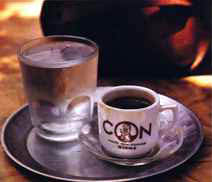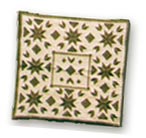|
 Kahve (short for
Kahvehane), is how we call here in North Cyprus, the little shop
we come across in the city's neighborhood and in the villages. In
kahves you are served cold and hot bevereges. Kahve (short for
Kahvehane), is how we call here in North Cyprus, the little shop
we come across in the city's neighborhood and in the villages. In
kahves you are served cold and hot bevereges.
For many years,
kahves, in the form of a public meeting-place restricted to men
played an important socio-economic role in the community. A small
"kahve" is typical of all villages in North Cyprus,
although in larger villages we come across more than just one
coffee-houses, or kahves. In villages, kahves are located in the
central square or the main street of the village. Quite often the
whole area is called "Kahvehane".
 Kahves
are generally for menfolk. Men at villages have their dinner at
home and then at down they gather there before starting off to
work. Usually, kahve is open all day long. It becomes the
gathering place for the elders and for those who do not go to
work. In some small villages the kahve often serves as a "bakkal",
that is the village grocery selling a limited number of goods.
Sometimes kahve also serves as the village post office as well. Kahves
are generally for menfolk. Men at villages have their dinner at
home and then at down they gather there before starting off to
work. Usually, kahve is open all day long. It becomes the
gathering place for the elders and for those who do not go to
work. In some small villages the kahve often serves as a "bakkal",
that is the village grocery selling a limited number of goods.
Sometimes kahve also serves as the village post office as well.
In the
traditional "kahve" you are served beverages mainly made
of herbs growing on the mountains or in the nearby prairies (e.g.
"Ihlamur" tea, mint tea, "Adachayi", anise
tea,...) and off course the traditional Turkish coffee, either
"sade" (without sugar), "orta" (medium), or
"shekerli" (with sugar). Among other things that are
served at the kahve are: "Lokum" (Turkish delight), or
"sujuk" (a Turkish sweet made of grape juice with
almonds or walnuts in it).
From an
architectural point of view, "kahve" is not noteworthy,
though the older kahves from the beginning of the century have
somewhat distinct characteristics with arched gates. Kahve is
mainly a huge room; its entrance faces the main street or the
village square. It has tables and chairs and a fire- place (which
was later replaced by a parafin stove). The shopkeeper's bench and
utensils are in the back of the room. You can hardly find a
toilet, or a kitchen in kahves. During summertime, tables and
chairs are placed outside, either in the street or in the square.
The same happens in winter and spring, whenever the sun is shining
and a few rays of sun are gladly welcomed.
 In the past, when
neither modern means of entertainment (radio, television) nor
contemporary means of communication were available, "kahve"
played an essential part in the village life. It was the only
place where men could either relax playing chess, cards, and other
traditional games like "tavla" (backgamon) or just talk
and tell stories especially during long winter nightswhen they did
not have anything else to do, given the fact that work was over
after sunset since there was no electricity either in those days.
Money did not exist back then, therefore people did not place any
bets. Ins- tead the prize for a game was a local product (raisins,
figs, walnuts, wine, almonds...). In the past, when
neither modern means of entertainment (radio, television) nor
contemporary means of communication were available, "kahve"
played an essential part in the village life. It was the only
place where men could either relax playing chess, cards, and other
traditional games like "tavla" (backgamon) or just talk
and tell stories especially during long winter nightswhen they did
not have anything else to do, given the fact that work was over
after sunset since there was no electricity either in those days.
Money did not exist back then, therefore people did not place any
bets. Ins- tead the prize for a game was a local product (raisins,
figs, walnuts, wine, almonds...).
When Karagöz
puppet theatre performers toured the countryside, they would often
end up in the local kahve where they would perform their art.
Kahve was then the scene of entertainment for the whole village;
that was one of the occasions when children and women would go
to the kahve. A few years following the end of the World War II,
feature films were screened in some kahves. Du- ring the War,
radios appeared in many kahves, thus they became the main source
of information for the whole village. Later with the televisions
appearing (from 1956 onwards), kahvehanes became the main source
of entertainment in the village where no household had the luxury
of a television set. Newspapers, with some delay, would always
come to kahvehane
Kahves, or
kahvehanes sometimes served for auctions, for meetings to discuss
community problems, for loan and payment arrangements and even for
matchmaking. Economic, social, and political issues were also
discussed.
 As in the other
Mediterranean societies, women would not sit and chat in the kahve
apart from Karagöz puppet theatre performances, films, and weddings.
When men were at kahve, women would usually gather in the
neighborhood where they would knit (e.g Lefgara lacework) and
chat. As in the other
Mediterranean societies, women would not sit and chat in the kahve
apart from Karagöz puppet theatre performances, films, and weddings.
When men were at kahve, women would usually gather in the
neighborhood where they would knit (e.g Lefgara lacework) and
chat.
For many years,
kahve was the heart of the village life. Today it is a place where
people meet to talk and play traditional games like "tavla",
although in cities and big towns its importance is considerably
reduced.
Here's
information and recipe of the world famous Turkish
coffee.
|









